Ann Lethbridge's Blog, page 7
October 20, 2015
It Happened One Christmas
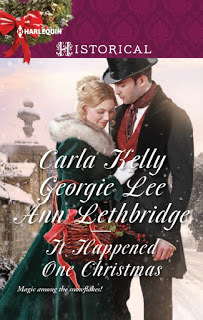 It is always exciting when a new book comes out. This one~~ three heartwarming series of Regency Christmas novellas from three Harlequin Historical authors~~ is out in print now.
It is always exciting when a new book comes out. This one~~ three heartwarming series of Regency Christmas novellas from three Harlequin Historical authors~~ is out in print now.E-books are available for preorder and will be available November 1st. If you didn't check it out already, visit my facebook page for details of the preorder contest.
Four Stars ~ Romantic Times "these three wonderful Regency authors showcase the joy of yuletide that shine with the magic of the season."
CHRISTMAS EVE PROPOSAL by Carla Kelly
Christmas gets more interesting when sailing master Ben Muir takes lodgings with Mandy Mathison! Because when her scandalous past is revealed, only he can save her future…
THE VISCOUNT'S CHRISTMAS KISS by Georgie Lee
Lily Rutherford is shocked to learn the man who snubbed her years before will be staying for Christmas. Can she forgive the viscount in time for a stolen kiss under the mistletoe?
WALLFLOWER, WIDOW…WIFE! by Ann Lethbridge
Penniless widow Cassandra Norton faces Christmas on the run with her two stepdaughters, until Adam Royston sweeps her off her feet and into his country estate!
Find it at Barnes and Noble
Pick it up at Amazon.com
Or go to your favorite bookstore
For preorders of the ebook, also visit
Ibooks
Kobo
and
Harlequin - where you can sign up for points towards other purchases.
Or, for more purchase links, go to my website annlethbridge.com
Until next time, when we will be taking another peek at Hever Castle.
Published on October 20, 2015 08:00
October 15, 2015
Regency Fashion October 1815
A Walking Dress for Autumn
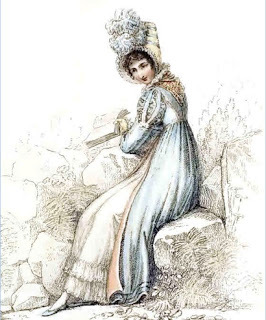 This charming outfit appeared in Ackermann's Repository.I love the way she is looking over her shoulder at us and the romantic rocky setting. Interestingly, it reminds me of the grotto at Stourhead, a place I visited in 2010. And here she is, caught in the middle of reading a romance perhaps.
This charming outfit appeared in Ackermann's Repository.I love the way she is looking over her shoulder at us and the romantic rocky setting. Interestingly, it reminds me of the grotto at Stourhead, a place I visited in 2010. And here she is, caught in the middle of reading a romance perhaps.
This is definitely a scene I need to write one of these days!
Here is the description provided by our favourite magazine.
A round robe of fine cambric or jaconot muslin, ornamented with a double flounce of French needle-work at the feet, under an open pelisse, composed of French grey sarsnet, lined with the salmon colour; the upper part of the sleeve lashed with satin of corresponding colour, fulled and let in.
A full ruff of needle-work and a small French handkerchief round the neck.
French hat of the satin straw, with a quilling of net round the rim; three rows of grey satin ribbon, plain or quilled, round the crown; and a full plume of white feathers, edged to correspond.
Slippers, blue or red morocco. Gloves, York tan.
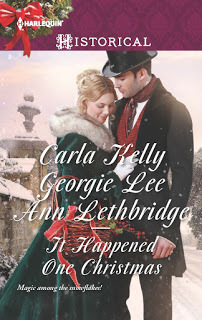
Coming soon-
It happened one Christmas. If you have missed the preorder contest which ends soon, check out my Facebook page or go to my website for details.
Until next time……...
 This charming outfit appeared in Ackermann's Repository.I love the way she is looking over her shoulder at us and the romantic rocky setting. Interestingly, it reminds me of the grotto at Stourhead, a place I visited in 2010. And here she is, caught in the middle of reading a romance perhaps.
This charming outfit appeared in Ackermann's Repository.I love the way she is looking over her shoulder at us and the romantic rocky setting. Interestingly, it reminds me of the grotto at Stourhead, a place I visited in 2010. And here she is, caught in the middle of reading a romance perhaps.This is definitely a scene I need to write one of these days!
Here is the description provided by our favourite magazine.
A round robe of fine cambric or jaconot muslin, ornamented with a double flounce of French needle-work at the feet, under an open pelisse, composed of French grey sarsnet, lined with the salmon colour; the upper part of the sleeve lashed with satin of corresponding colour, fulled and let in.
A full ruff of needle-work and a small French handkerchief round the neck.
French hat of the satin straw, with a quilling of net round the rim; three rows of grey satin ribbon, plain or quilled, round the crown; and a full plume of white feathers, edged to correspond.
Slippers, blue or red morocco. Gloves, York tan.

Coming soon-
It happened one Christmas. If you have missed the preorder contest which ends soon, check out my Facebook page or go to my website for details.
Until next time……...
Published on October 15, 2015 09:00
October 8, 2015
Regency Fashion ~ October 1815
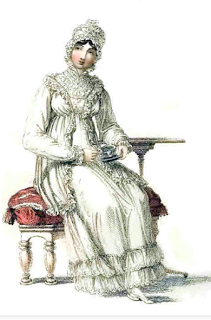 Morning Dress October 1815
Morning Dress October 1815From Ackermann's Repository
1815 seems to be the year of the ruffle, as I look back over several of this year's fashion blogs.
This one looks more like a nightgown to me and the use of the word negligee in the description makes me realize why. Of course morning dresses were designed for wearing around the house while looking pretty. I always love it when they add furniture to the picture.
Here is the official description
A CAMBRIC muslin petticoat, ornamented at the feet with a double flounce of French work, appliqued with a narrow heading of the same;
the body, from the shoulder to the neck, gathered full into narrow trimming, corresponding with the heading of the flounce; a military collar, frilled with the French work;
short French negligée, open in the front, and trimmed entirely round to correspond; long loose sleeve, gathered into a narrow trimming at the wrist, with a ruffle of the same French work. A round cap, composed of white satin and quilled lace; a white satin rose in the front.
Stockings, ribbed silk.
Slippers, red morocco or black kid.
Until next time………..
Published on October 08, 2015 08:00
September 29, 2015
Regency Britain - Hever Castle
This castle is likely one of the most famous in Britain, having been home to two of Britain's Queens. Ann Boleyn and Ann of Cleves.
 It was built as a defensive castle in the 13th Century,
It was built as a defensive castle in the 13th Century,
 by William de Hever, Sheriff under Edward I. Even though after going into disrepair for several decades, the defensive nature of it is easily seen.
by William de Hever, Sheriff under Edward I. Even though after going into disrepair for several decades, the defensive nature of it is easily seen.
One can imagine it firing the imagination of little Regency girls and boys playing knights and maidens in distress, or maiden going out to battle the invading armies.
And yes, that is a moat all around the outside. One passes over a bridge to get into the house.
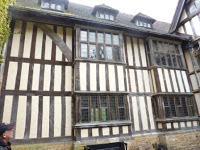
 It was in the fifteenth and sixteenth centuries that Hever Castle was owned by the Bullens, relatives of Ann Boleyn. By this time, the defensive nature was a thing of the past. It was a Tudor home.
It was in the fifteenth and sixteenth centuries that Hever Castle was owned by the Bullens, relatives of Ann Boleyn. By this time, the defensive nature was a thing of the past. It was a Tudor home.
These photo's clearly illustrate that, but although it was Tudor in style during the Regency it was owned by Jane Waldo, the daughter of a knight of the realm, Sir Timothy Waldo, so it could easily be a back drop for a Regency story.
Next time, we go inside the house. Untill then.....
 It was built as a defensive castle in the 13th Century,
It was built as a defensive castle in the 13th Century, by William de Hever, Sheriff under Edward I. Even though after going into disrepair for several decades, the defensive nature of it is easily seen.
by William de Hever, Sheriff under Edward I. Even though after going into disrepair for several decades, the defensive nature of it is easily seen.One can imagine it firing the imagination of little Regency girls and boys playing knights and maidens in distress, or maiden going out to battle the invading armies.
And yes, that is a moat all around the outside. One passes over a bridge to get into the house.

 It was in the fifteenth and sixteenth centuries that Hever Castle was owned by the Bullens, relatives of Ann Boleyn. By this time, the defensive nature was a thing of the past. It was a Tudor home.
It was in the fifteenth and sixteenth centuries that Hever Castle was owned by the Bullens, relatives of Ann Boleyn. By this time, the defensive nature was a thing of the past. It was a Tudor home.These photo's clearly illustrate that, but although it was Tudor in style during the Regency it was owned by Jane Waldo, the daughter of a knight of the realm, Sir Timothy Waldo, so it could easily be a back drop for a Regency story.
Next time, we go inside the house. Untill then.....
Published on September 29, 2015 08:00
September 22, 2015
Regency Fashion September 1815
As we move into Fall, this September dress makes a bit impression for sheer femininity.
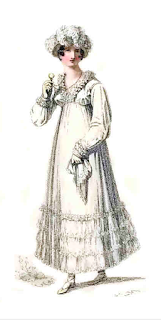 A Carriage Dress from Ackermans for September 1815. I love that she has a lorgnette in one hand and a lacy handkerchief in the other. I can remember carrying real handkerchiefs about my person as a child. I still have a gift box of embroidered ones given to me by my grandmother somewhere. Paper tissues just don't quite feel the same do they? Although I do like the little packets with pretty designs on the wrapping that you keep in your purse. I digress.
A Carriage Dress from Ackermans for September 1815. I love that she has a lorgnette in one hand and a lacy handkerchief in the other. I can remember carrying real handkerchiefs about my person as a child. I still have a gift box of embroidered ones given to me by my grandmother somewhere. Paper tissues just don't quite feel the same do they? Although I do like the little packets with pretty designs on the wrapping that you keep in your purse. I digress.
Ackermann's describes this dress as follows.
Carriage Dress September 1815
Cambric muslin, jaconet, or French cambric dress, of short walking length, ornamented round the skirt with four borders of embroidery laid on; long sleeve, the fullness at the wrist confined in a bracelet of corresponding embroidery let in.
Plain handkerchief, front trimmed en suite. The back of the dress broad and plain, sloped low between the shoulders; the fullness of the petticoat extended round the waist; the sleeve worn considerably off the shoulder, and the waist very short.
The Anglesea chip hat, decorated with a full cluster of ostrich feathers, drooping forward. Sandals, kid, of the Pomona green colour. Gloves, Limerick or York tan.
I think this is a very flattering style of hat and one can imagine a lady able to stride out in a dress of this shape. I think this is an outfit I would use in a story.
Until next time
 A Carriage Dress from Ackermans for September 1815. I love that she has a lorgnette in one hand and a lacy handkerchief in the other. I can remember carrying real handkerchiefs about my person as a child. I still have a gift box of embroidered ones given to me by my grandmother somewhere. Paper tissues just don't quite feel the same do they? Although I do like the little packets with pretty designs on the wrapping that you keep in your purse. I digress.
A Carriage Dress from Ackermans for September 1815. I love that she has a lorgnette in one hand and a lacy handkerchief in the other. I can remember carrying real handkerchiefs about my person as a child. I still have a gift box of embroidered ones given to me by my grandmother somewhere. Paper tissues just don't quite feel the same do they? Although I do like the little packets with pretty designs on the wrapping that you keep in your purse. I digress. Ackermann's describes this dress as follows.
Carriage Dress September 1815
Cambric muslin, jaconet, or French cambric dress, of short walking length, ornamented round the skirt with four borders of embroidery laid on; long sleeve, the fullness at the wrist confined in a bracelet of corresponding embroidery let in.
Plain handkerchief, front trimmed en suite. The back of the dress broad and plain, sloped low between the shoulders; the fullness of the petticoat extended round the waist; the sleeve worn considerably off the shoulder, and the waist very short.
The Anglesea chip hat, decorated with a full cluster of ostrich feathers, drooping forward. Sandals, kid, of the Pomona green colour. Gloves, Limerick or York tan.
I think this is a very flattering style of hat and one can imagine a lady able to stride out in a dress of this shape. I think this is an outfit I would use in a story.
Until next time
Published on September 22, 2015 08:00
September 17, 2015
No Conventional Miss
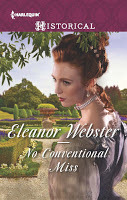
Today we welcome debut author writing for Harlequin Historicals, Eleanor Webster, whose new book No Conventional Miss is out in October 2015.
She's always been different… Amaryllis Gibson is an unlikely debutante. She favors fact over fashion, cares not for "proper" conversation and is haunted by ghostly visions which could land her in the madhouse! Marriage is definitely the last thing on Rilla's mind… But when she's caught in a compromising position with Viscount Wyburn, suddenly she finds herself betrothed! And worse, his powerful presence only increases her visions. By shedding light on the viscount's past, can Rilla gain his trust and win him round to her more…unconventional traits?
Welcome Eleanor, please tell us something about your journey to authorship and the research you undertook for this book.
I have always loved the Regency Period. Perhaps this developed from a youthful over- indulgence in Georgette Heyer but I think it is more than that. Regency society is one poised for change. The inventions of the Industrial Revolution are emerging, bringing with them the anticipation of societal transformation. Years ago, a friend got a summer job in Austria – we lived in Canada - by connecting his computer through the telephone lines. I was fascinated. It was a glimpse into the future and, although I could not anticipate its impact, I felt an emotional charge, an innate gut-level understanding that I was witnessing a game changer.
 I wonder if people observing Richard Trevithick's first steam-driven railway journey in 1804 felt a similar charge. Or those brave passengers who boarded his ‘Catch-me-who-can’ locomotive in London. Granted, many would have scoffed. Trevithick’s locomotives had a habit of breaking the rails and falling over but I still think there would have been an atmosphere – a feeling – at least, for those with imagination and the spirit of innovation
I wonder if people observing Richard Trevithick's first steam-driven railway journey in 1804 felt a similar charge. Or those brave passengers who boarded his ‘Catch-me-who-can’ locomotive in London. Granted, many would have scoffed. Trevithick’s locomotives had a habit of breaking the rails and falling over but I still think there would have been an atmosphere – a feeling – at least, for those with imagination and the spirit of innovationMy heroine, Amaryllis (Rilla) Gibson in the October Harlequin Historical release, No Conventional Miss , has exactly this spirit. Rilla is keenly interested in force, momentum and any number of ‘unladylike’ activities. She is working on an automated butter churn and has an eager enthusiasm for all things scientific.
As I began my research, I wondered whether any ‘real-life’ Regency woman might be similar to Rilla or were such accomplishments destined to remain in the fictional realm. Then I found Sarah Guppy (1770-1852). Sarah was born in Birmingham and patented numerous designs. Indeed, she achieved considerable financial success, earning a contract from the British Navy worth £40,000 for a device to prevent the growth of barnacles on ships. And then there is my personal favorite; her invention of a tea or coffee urn which also cooked eggs and warmed toast.
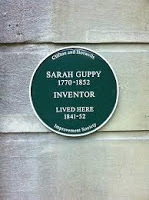 Needless to say, the number of female Regency inventors is limited – at least those publicly acknowledged. Indeed, women were not even permitted to become fellows of Britain foremost scientific institution, the Royal Society of London, until 1945.
Needless to say, the number of female Regency inventors is limited – at least those publicly acknowledged. Indeed, women were not even permitted to become fellows of Britain foremost scientific institution, the Royal Society of London, until 1945.However, current historians are starting to rediscover people like Sarah and recognize female scientific accomplishments during the 18th and 19th century. Richard Holmes in the The Age of Wonder argues that women contributed to a far greater extent than is commonly acknowledged. Moreover, he states that they saw science in the context of a wider world, raising questions about its duties and moral responsibilities.
http://www.theguardian.com/science/2010/nov/21/royal-society-lost-women-scientists
As for me, the Regency Period will always fascinate and I will continue to write about those women, both real and imagined, who had a zest for living, an imagination and the spirit of innovation.
Richard Holmes's The Age of Wonder won the Royal Society's Science Books Prize for 2009; its sequel, The Lost Women of Victorian Science, will be published by HarperCollins and Pantheon USA
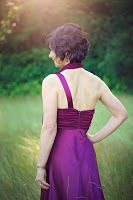 Eleanor loves high-heels and sun, which is ironic as she lives in northern Canada, the land of snowhills and unflattering footwear. Various crafting experiences, including a nasty glue-gun episode, have proven that her creative soul is best expressed through the written word. Eleanor is currently pursuing a doctoral degree in psychology and holds an undergraduate degree in history and creative writing. She loves to use her writing to explore her fascination with the past.
Eleanor loves high-heels and sun, which is ironic as she lives in northern Canada, the land of snowhills and unflattering footwear. Various crafting experiences, including a nasty glue-gun episode, have proven that her creative soul is best expressed through the written word. Eleanor is currently pursuing a doctoral degree in psychology and holds an undergraduate degree in history and creative writing. She loves to use her writing to explore her fascination with the past.
Published on September 17, 2015 08:00
Today we welcome debut author writing for Harlequin Histo...

Today we welcome debut author writing for Harlequin Historicals, Eleanor Webster, whose new book No Conventional Miss is out in October 2015.
She's always been different… Amaryllis Gibson is an unlikely debutante. She favors fact over fashion, cares not for "proper" conversation and is haunted by ghostly visions which could land her in the madhouse! Marriage is definitely the last thing on Rilla's mind… But when she's caught in a compromising position with Viscount Wyburn, suddenly she finds herself betrothed! And worse, his powerful presence only increases her visions. By shedding light on the viscount's past, can Rilla gain his trust and win him round to her more…unconventional traits?
Welcome Eleanor, please tell us something about your journey to authorship and the research you undertook for this book.
I have always loved the Regency Period. Perhaps this developed from a youthful over- indulgence in Georgette Heyer but I think it is more than that. Regency society is one poised for change. The inventions of the Industrial Revolution are emerging, bringing with them the anticipation of societal transformation. Years ago, a friend got a summer job in Austria – we lived in Canada - by connecting his computer through the telephone lines. I was fascinated. It was a glimpse into the future and, although I could not anticipate its impact, I felt an emotional charge, an innate gut-level understanding that I was witnessing a game changer.
 I wonder if people observing Richard Trevithick's first steam-driven railway journey in 1804 felt a similar charge. Or those brave passengers who boarded his ‘Catch-me-who-can’ locomotive in London. Granted, many would have scoffed. Trevithick’s locomotives had a habit of breaking the rails and falling over but I still think there would have been an atmosphere – a feeling – at least, for those with imagination and the spirit of innovation
I wonder if people observing Richard Trevithick's first steam-driven railway journey in 1804 felt a similar charge. Or those brave passengers who boarded his ‘Catch-me-who-can’ locomotive in London. Granted, many would have scoffed. Trevithick’s locomotives had a habit of breaking the rails and falling over but I still think there would have been an atmosphere – a feeling – at least, for those with imagination and the spirit of innovationMy heroine, Amaryllis (Rilla) Gibson in the October Harlequin Historical release, No Conventional Miss , has exactly this spirit. Rilla is keenly interested in force, momentum and any number of ‘unladylike’ activities. She is working on an automated butter churn and has an eager enthusiasm for all things scientific.
As I began my research, I wondered whether any ‘real-life’ Regency woman might be similar to Rilla or were such accomplishments destined to remain in the fictional realm. Then I found Sarah Guppy (1770-1852). Sarah was born in Birmingham and patented numerous designs. Indeed, she achieved considerable financial success, earning a contract from the British Navy worth £40,000 for a device to prevent the growth of barnacles on ships. And then there is my personal favorite; her invention of a tea or coffee urn which also cooked eggs and warmed toast.
 Needless to say, the number of female Regency inventors is limited – at least those publicly acknowledged. Indeed, women were not even permitted to become fellows of Britain foremost scientific institution, the Royal Society of London, until 1945.
Needless to say, the number of female Regency inventors is limited – at least those publicly acknowledged. Indeed, women were not even permitted to become fellows of Britain foremost scientific institution, the Royal Society of London, until 1945.However, current historians are starting to rediscover people like Sarah and recognize female scientific accomplishments during the 18th and 19th century. Richard Holmes in the The Age of Wonder argues that women contributed to a far greater extent than is commonly acknowledged. Moreover, he states that they saw science in the context of a wider world, raising questions about its duties and moral responsibilities.
http://www.theguardian.com/science/2010/nov/21/royal-society-lost-women-scientists
As for me, the Regency Period will always fascinate and I will continue to write about those women, both real and imagined, who had a zest for living, an imagination and the spirit of innovation.
Richard Holmes's The Age of Wonder won the Royal Society's Science Books Prize for 2009; its sequel, The Lost Women of Victorian Science, will be published by HarperCollins and Pantheon USA
 Eleanor loves high-heels and sun, which is ironic as she lives in northern Canada, the land of snowhills and unflattering footwear. Various crafting experiences, including a nasty glue-gun episode, have proven that her creative soul is best expressed through the written word. Eleanor is currently pursuing a doctoral degree in psychology and holds an undergraduate degree in history and creative writing. She loves to use her writing to explore her fascination with the past.
Eleanor loves high-heels and sun, which is ironic as she lives in northern Canada, the land of snowhills and unflattering footwear. Various crafting experiences, including a nasty glue-gun episode, have proven that her creative soul is best expressed through the written word. Eleanor is currently pursuing a doctoral degree in psychology and holds an undergraduate degree in history and creative writing. She loves to use her writing to explore her fascination with the past.
Published on September 17, 2015 08:00
September 14, 2015
Regency Fashion September 1815
As we move into the cooler weather for autumn we see it reflected in this Dinner Dress from Ackermann's for September 1815
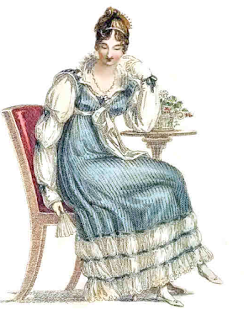 The magazine describes this gown as follows
The magazine describes this gown as follows
A WHITE satin slip, worn under a dress made in primrose-coloured French gauze, terminating at the feet with a full flounce of blond lace, headed with a double border of the same, gathered in full, and confined with folds of satin, of corresponding colour to the dress;
handkerchief-front trimmed with white satin, and a falling collar of blond lace; long sleeve of white satin, the fullness upon the shoulder confined under an epaulet of the French gauze, trimmed with white satin;
the sleeve drawn alternatingly across the arm with the evening primrose-coloured satin ribbon. Long sash of white satin, tied in front.
The ends of the hind hair brought forward, to fall in ringlets over the temple, confined with a plain white satin ribbon, and ornamented with a tiara of pearl.
Necklace to correspond. Gloves, French kid. Slippers, white satin.
Well, to me, primrose is a yellow colour and the artist made this blue. I almost want to get my colouring pencils out and fix it. Perhaps yellow did not work well in print to show the difference between the blond lace etc. and the French gauze. Not that I don't really like the blue, it just doesn't say primrose to me.
Enjoy…
Until next time, when we will be meeting Eleanor Webster and her debut book, No Conventional Miss…….
For more information about Ann Lethbridge and her books, visit annlethbridge.com
 The magazine describes this gown as follows
The magazine describes this gown as followsA WHITE satin slip, worn under a dress made in primrose-coloured French gauze, terminating at the feet with a full flounce of blond lace, headed with a double border of the same, gathered in full, and confined with folds of satin, of corresponding colour to the dress;
handkerchief-front trimmed with white satin, and a falling collar of blond lace; long sleeve of white satin, the fullness upon the shoulder confined under an epaulet of the French gauze, trimmed with white satin;
the sleeve drawn alternatingly across the arm with the evening primrose-coloured satin ribbon. Long sash of white satin, tied in front.
The ends of the hind hair brought forward, to fall in ringlets over the temple, confined with a plain white satin ribbon, and ornamented with a tiara of pearl.
Necklace to correspond. Gloves, French kid. Slippers, white satin.
Well, to me, primrose is a yellow colour and the artist made this blue. I almost want to get my colouring pencils out and fix it. Perhaps yellow did not work well in print to show the difference between the blond lace etc. and the French gauze. Not that I don't really like the blue, it just doesn't say primrose to me.
Enjoy…
Until next time, when we will be meeting Eleanor Webster and her debut book, No Conventional Miss…….
For more information about Ann Lethbridge and her books, visit annlethbridge.com
Published on September 14, 2015 08:00
September 10, 2015
Regency Fashions August 1815
Books being what they are we are playing catchup. I wanted you to have this August dress before I started on September's offerings.
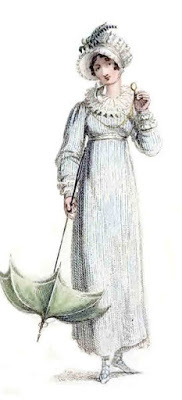 This is a summer Promenade Dress from Ackermann's Repository and this is the extracted description:
This is a summer Promenade Dress from Ackermann's Repository and this is the extracted description:
High dress, with plain body, buttoned or laced behind, composed of a rich satin-striped sarsnet, of celestial blue and white colour, trimmed at the feet with white satin;
long loose sleeve, confined at the wrist with a fulling of tull, edged with white satin;
a deep full ruff, of the French work, round the neck; a short sash of white satin ribbon, tied behind.
A French bonnet, composed of tull fulled in, and alternate folds of white satin; a roll of white satin, laced with tull, ornaments the edge of the bonnet; satin strings, tied under the ear.
Necklace of Oriental-gold.
Stockings elastic or ribbed silk.
Sandals crossed high up the ankle with blue ribbon. Gloves Limerick or blue kid. Parasol of shaded silk.
i thought this looked particularly elegant though I am not a fan of ruffs.
Until next time…..
 This is a summer Promenade Dress from Ackermann's Repository and this is the extracted description:
This is a summer Promenade Dress from Ackermann's Repository and this is the extracted description:High dress, with plain body, buttoned or laced behind, composed of a rich satin-striped sarsnet, of celestial blue and white colour, trimmed at the feet with white satin;
long loose sleeve, confined at the wrist with a fulling of tull, edged with white satin;
a deep full ruff, of the French work, round the neck; a short sash of white satin ribbon, tied behind.
A French bonnet, composed of tull fulled in, and alternate folds of white satin; a roll of white satin, laced with tull, ornaments the edge of the bonnet; satin strings, tied under the ear.
Necklace of Oriental-gold.
Stockings elastic or ribbed silk.
Sandals crossed high up the ankle with blue ribbon. Gloves Limerick or blue kid. Parasol of shaded silk.
i thought this looked particularly elegant though I am not a fan of ruffs.
Until next time…..
Published on September 10, 2015 08:00
August 25, 2015
Regency Inns
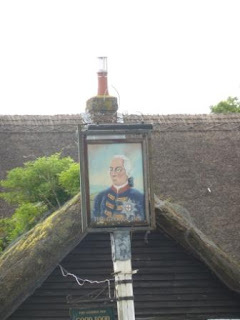
Pubs hold a very special place in Britain as they did in the Regency. Here are a couple in the small village of Thruxton, Hampshire where we stayed overnight. Both inns were built well before the Regency.
The George Inn is a 17th century coaching inn which a character in a book might well have stopped at en route by stage or perhaps postchaise.

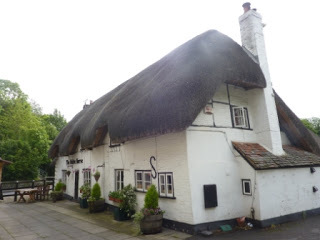 The White Horse Inn, dating back to the fourteenth century, however, is very different. It is located in the village near "Mullenspond" and in 1761 a turnpike gate was set up opposite it for the turnpike road between Amesbury and Andover.
The White Horse Inn, dating back to the fourteenth century, however, is very different. It is located in the village near "Mullenspond" and in 1761 a turnpike gate was set up opposite it for the turnpike road between Amesbury and Andover.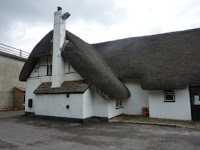
The two views of the front and back of the inn provide a sense of its charm and a wonderful setting for a trip during Regency times.
Until next time
Published on August 25, 2015 08:30



